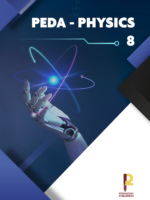-
Peda-Arabic Grade 8
Developed according to the new curricula of the Educational Research and Development Center, the Arabic language textbook for eighth grade includes the following topics:
Nature and scenery, biography and memories, the art of rhetoric, journalism and media, national values, and social values. In each topic, students use several skills, including observation and inference, active listening and reading, analysis and interpretation, understanding of vocabulary and expressions (enriching the linguistic dictionary), acquiring grammar and eloquence, written expression, listening, cognitive enrichment, and self-learning
-
Peda-Chemistry Grade 8
The Grade 8 Chemistry textbook was developed in accordance with the new CRDP curriculum. This book covers the following topics:
Electric Charge, Electric Discharge, Classification of Substances, Structure of Matter, Chemical Language, Chemical Equations and Reactions, Rates of Chemical Reactions, and Acidic and Basic Solutions.
Each chapter begins with an introduction featuring a short video and figures and is divided into several activities, which include parts such as “I Reflect” (brainstorming), “I Discover” (learning new information), “I Wrap-Up” (conclusion), “I Evaluate Myself” (evaluation), and “Me the Chemist” (applying chemistry in everyday life). At the end of each chapter, the activities are followed by “Essentials” (summary), “Thinking Outside the Box” (applying chemistry in real life on a larger scale), and some exercises.
-
Peda-English Grade 8
English grade 1 textbook is developed in accordance with the new curricula of the CRDP. This book covers the following topics:
Survival, Sources of Energy and Pollution, Nutritional Science, Friendship, Folktales, Information Technology, Natural Phenomena, World Issues, Society, and Marketing. In each topic, students go through the following skills: Comprehension, Speaking, Pre-Reading, Vocabulary, Reading, Post-Reading, Grammar, and Writing
The book also includes a range of interactive elements, such as exercises, games, and educational videos, to help students engage with the content in a fun and enjoyable way.
With its comprehensive coverage of key language skills and engaging presentation of content, the English grade 8 textbook is an invaluable tool for any young learner looking to improve their English language proficiency
-
Peda-History Grade 8
In accordance with the new curricula of the Educational Center for Research and Development, the 8th grade history book has been developed to delve deeper into the rich and diverse history of Lebanon and Europe.
The first section of the book delves into the intriguing history of the Lebanese Emirate during the relevant period, exploring the political, social, and economic factors that shaped this period in Lebanon’s history. The second section is equally captivating, taking a deep dive into the Lebanese Emirate during the era of the Shihab family, highlighting the significant developments and transformations that occurred during this time.
Moving on, the third section explores the era of the Qaimaqams, providing an in-depth analysis of the political and social factors that led to the establishment of this unique system of governance in Lebanon. The fourth section shifts the focus to the Mutassarifia, a system of local government that emerged in Lebanon during the Ottoman era, examining its impact on the region’s history and development.
Finally, the fifth section of the book explores the captivating history of Europe in the 18th and 19th centuries, highlighting the significant events and movements that transformed the continent during this era.
-
Peda-Math Grade 8
The Math Grade 8 textbook is developed in accordance with the new curricula of the CRDP. This book covers the following topics:
Powers, powers of 10, square roots, GCD, LCM, proportions, fractions, remarkable identities, equations, inequalities, spotting, midpoint theorem, right triangles, translations and vectors, circles, arcs and angles, parallelograms, rhombuses, squares, rectangles, space, and statistics.
In each topic, students go through the following steps to master the learning objectives: introducing new information by building on previous knowledge through the parts “To Think,” “Activity,” and “I Conclude,” and applying directly in the “Application.” They wrap up the rules in the “Rules for You” section and then practice through exercises escalating in their levels
-
Peda-Physics Grade 8
The Grade 8 Physics textbook was developed in accordance with the new CRDP curriculum. This book covers the following chapters:
Motion, Velocity, Mechanical Action, Forces, Weight, Work and Power of a Force, Mechanical Energy, Different Forms of Energy, Energy Sources, Mechanical Waves, Sound Waves, Electromagnetic Waves, Colors, Rectilinear Propagation of Light, and Light Reflection.
Each chapter is divided into several activities that include various parts: the brainstorming section, “I Discover” for learning new information, “I Get the Point” as the conclusion, “I Get Evaluated” where students solve exercises for assessment, and “Let’s Learn More” which provides additional information about the lesson. At the end of each chapter, the activities are followed by “Essentials” (the summary) and some exercises.
-
Peda-Science Grade 8
The Grade 8 Science textbook is developed in accordance with the new CRDP curriculum. This book covers the following topics:
The Immune Response, Disorders of the Immune System, Methods of Antimicrobial Prophylaxis and Therapeutics, Geology, Rock Deformation, Dynamics of the Terrestrial Globe, and Geology and Human Responsibility.
Each unit is divided into chapters, and each chapter is divided into activities. The activities include: an example from real-life situations, “Let’s Discover” which contains documents that match the objectives of the activity, “Let’s Write” and “Let’s Learn” which includes a summary, “Let’s Practice” which features exercises about the main objectives, and “Let’s Enjoy Science” which involves making crafts, conducting experiments, or researching








